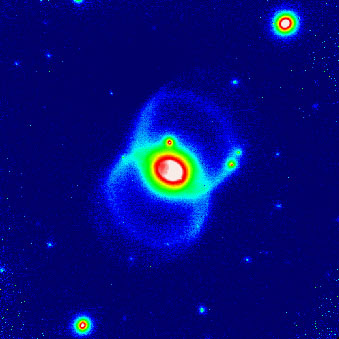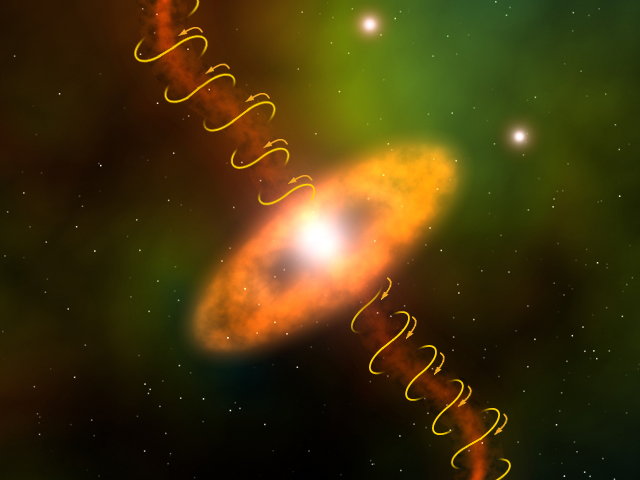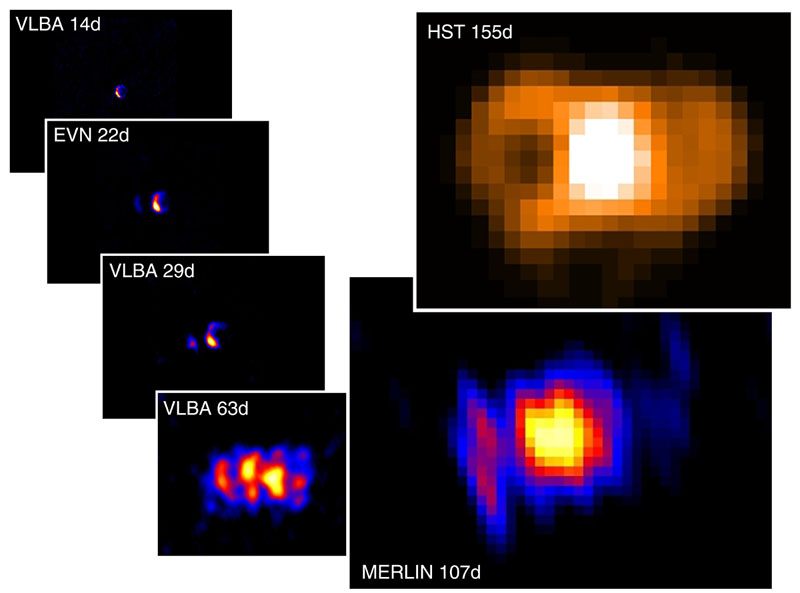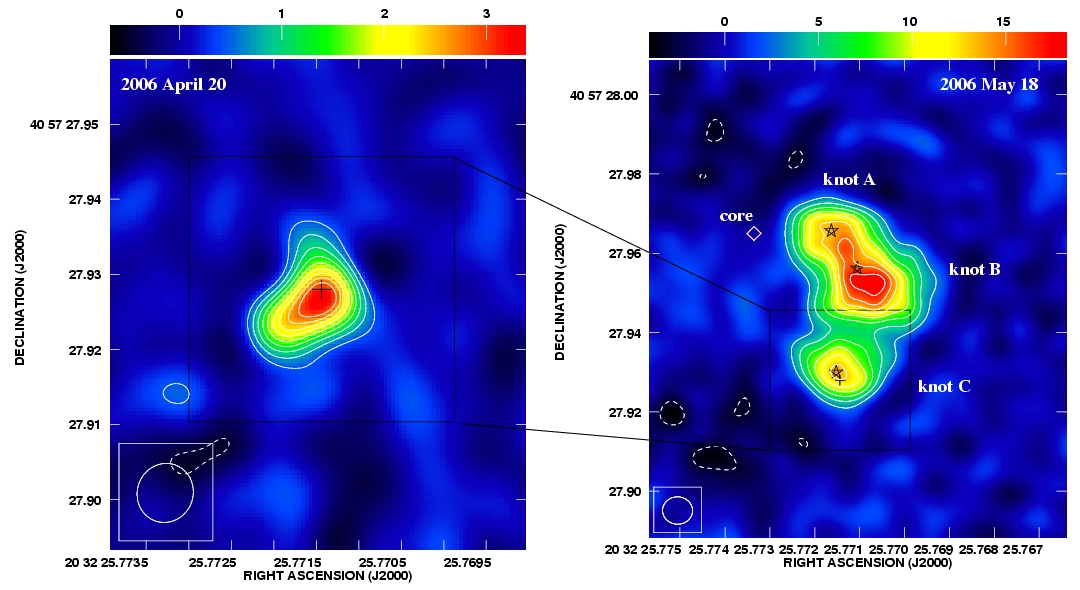
Infra-red image of the planetary nebula MyCn18, taken with NACO on the Very Large Telescope. The strongly waisted, hourglass shape of the nebula is believed to indicate that the central star must be binary.
Image: VLT, ESO, Myfanwy Lloyd (JBCA)
Outflows and Evolved Stars
Our group has expertise in both multifrequency observations and modelling of stellar evolution, and carries out research on a wide variety of different types of evolved stars. We can therefore take a unifying approach to the study of the physical processes involved, across a range of extreme conditions.
Gas ejected from stars forms a major constituent of the interstellar medium (ISM). Interaction of the outflowing material with the ISM is an important tracer of conditions and the mass loss process is fundamental to the late stages of stellar evolution. The compact remnants of stellar evolution - white dwarfs, neutron stars and black holes - are generally rotating more slowly than simple angular momentum conservation of a collapsing star would suggest; outflows therefore appear to be necessary in removing angular momentum from the stellar system.
We have active research programmes on planetary nebulae (the end-points of evolution of Sun-like stars), novae (nuclear explosions on the surface of white dwarf stars in binary star systems) and other accreting binaries (star systems in which matter is accreted onto a compact object - a black hole, neutron star or white dwarf) such as microquasars .
Shaping and Kinematical Evolution of Planetary Nebulae
The stellar outflows which enrich the interstellar medium are affected by complex physical phenomena. The traditional model for Asymptotic Giant Branch (AGB) stars is that of a slow stellar wind (moving at 10-20 kilometres per second) which removes the stellar envelope. Once the hydrogen shell has been reduced to around 0.01 solar masses the star heats up rapidly and begins to ionise the ejecta, forming a planetary nebula. At the same time the wind velocity increases dramatically while the mass-loss rate reduces. The fast wind sweeps up the preceding slow wind. This is the so-called interacting stellar wind model (ISW), developed in Manchester by Kahn & West. The interaction amplifies any density asymmetries already present in the slow wind, and this is at the base of our understanding of the intricate structures seen in planetary nebulae.
The ionised ejecta are important tracers of two aspects: the morphologies trace the physics and origin of the superwind, while the bright nebular emission lines allow us to determine abundances - thus far only for light elements - accurate to 0.05-0.1 dex. We are studying close binary evolution leading to circumstellar disks and jets, and we aim to obtain the first abundances of s-process elements.

Artist's impression of the dying star W43A showing the twin jets being confined by the magnetic fields (represented by the yellow field lines).
Image: NSF, Phil Diamond & Wouter Vlemmings (JBCA)
At the highest angular resolution, as provided by, for example, HST, MERLIN, VLBI and the VLT and Gemini 8-m class telescopes, planetary nebulae (PNe) show a wealth of structures, including collimated, hypersonic ejecta and strongly cusped waists, as seen in the Etched Hourglass nebula, MyCn18. We have recently achieved two major milestones:
- We have pioneered optical interferometry with the VLTI, discovering compact (10-50 AU) circumstellar disks surviving in some PNe. These cannot be explained within the ISW models. Instead, the disks are believed to have formed from binary interactions where angular momentum is transfered to the ejecta.
- We followed-up on our discovery of the precessing 'water fountain' molecular jet in the proto-PNe W43A by establishing that it is confined by a toroidal magnetic field - this is the first direct evidence of a magnetically confined jet in astrophysics. Our data indicates that the magnetic field may originate, and the jet may have been launched, from a binary system.
The close binary systems are the progenitors of interacting systems containing white dwarfs: nova systems, cataclysmic variables and supernovae Ia. Which systems evolve to each of these stages depends on their evolution through the superwind. At this time the interaction reduces the size of the orbit (during a common envelope or common atmosphere), and also determines the mass of the final components. Both parameters in turn determine the nova frequency and/or supernova Ia rate. The binary interaction during the superwind and other aspects of planetary nebulae formation therefore has ramifications across a wide area of astrophysics.
Planetary nebulae with close binary companions show periods of hours to days. However, the little available data suggests that post-AGB stars with circumstellar disks have orbital periods of > 100 days. Several different evolutionary tracks may co-exist. Our work on morphologies of PNe with close binary nuclei has shown highly collimated jets, and provided the first proof that these form perpendicular to the orbital plane. We are working to relate the nebular morphologies to the orbital parameters and evolution, providing for the first time a tracer of an unobservable but crucial phase of binary evolution with broader relevance to astrophysics. To this end we are combining observations at extremely high angular resolution (e-Merlin, VLTI) with kinematical observations and newly developed hydrodynamical models.
Mass ejection from novae
Novae are interacting binary systems whose main feature is a white dwarf accreting matter from a companion, either a main-sequence dwarf or occasionally an evolved star like a red giant. Explosions are caused by runaway thermonuclear reactions in the accreted material leading to ejection at speeds of several hundreds to thousands of km per second. The ejected matter is a mix of material from the companion, processed by nuclear reactions and, perhaps, some material from the white dwarf. The expanding ejecta are often not spherical and it is commonly assumed that this is the result of interaction with the companion star in a common-envelope like phase (although other factors like the magnetic field and spin of the white dwarf cannot be excluded). Nova systems are therefore excellent laboratories for studying a wide range of astrophysical phenomena including accretion, nuclear reactions, shock waves, jet formation, photoionisation and dust formation. In some cases (when the white dwarf grows in mass as a result of accretion) even providing possible supernova progenitors.
Working with colleagues from several UK and international universities, our group has for many years carried out theoretical and observational studies of novae, linking them to planetary nebulae and supernovae, and combining modelling with observation at wavelengths ranging from the radio to the X-ray. The work has included: multifrequency monitoring of novae in outburst; structural studies of nova ejecta using a combination of imaging and spectroscopy; and hydrodynamic simulations of mass-loss using parallelised numerical codes developed in-house and also applied to PNe and astrophysical jets.
An excellent case study is the multi-frequency campaign of observations on the 2006 explosion of the nova RS Ophiuchi. Working as part of an international team of collaborators, we obtained observing time on a wide range of telescopes including MERLIN, VLBA, EVN, VLA, VLTI, Swift, Chandra, XMM-Newton, HST, Liverpool Telescope and Spitzer, playing a leading role in the radio imaging and hydrodynamical modelling of the shock. In 2007 we were co-organisers of an international workshop on this event and its implications at the University of Keele.

A sequence of high-resolution radio and optical images of the recurrent nova RS Oph (labelled by number of days after outburst from 2006 Feb 26) showing the development of the shock wave from an asymmetric ring into a bi-lobal E-W structure. The VLBI images (VLBA and EVN) are each 0.25 arcsec in height, the MERLIN image and the HST image (deconvolved [OIII]) are shown to the same scale.
Image: VLBA, EVN, MERLIN, HST, Tim O'Brien (JBCA)
Microquasars
The study of accreting binaries - systems in which a comparatively normal star is in orbit around a compact object such as a white dwarf, neutron star or black hole - gives a unique opportunity to study extreme astrophysics in detail. Such objects within our galaxy are often bright in several wavebands, and observations coupled with knowledge of the fundamental physics have lead to major advances in our understanding of the accretion process. Accretion is an efficient mechanism of energy release, and is ubiquitous in astrophysics. Indeed a fundamental plane has been discovered which links radio emitting X-ray binaries to active galaxies and powerful quasars, indicating a simple scaling with mass of the central black hole.

Before and after radio images of Cygnus X-3 showing the ejection of a jet from the region around the black hole.
Image: Ralph Spencer (JBCA)
Many of these objects show evidence of collimated flows - whether in the form of bi-polar flows (from white dwarf binaries) or well collimated jets from neutron stars or black holes. We are studying the collimation mechanism - is it a simple case of how deep a potential is available? At first sight this appears so, however our recent work has shown that bona-fide neutron star binaries like the black-hole candidate microquasars also have super-luminal, collimated radio jets. Some bipolar flows are also well collimated, with opening angles of only a few degrees. Other processes must be at work, perhaps unrelated to the nature of the compact object, with the perhaps essential requirement of an active accretion disk being present. What has become clear over recent years is that the global properties of the jet result from the accretion flow rather than the nature of the compact object. Recent results have shown that neutron star binaries are around 30 times weaker in the radio than black hole binaries with comparable X-ray luminosity. The difference in radio power suggests that variation in some property (magnetic field, presence of a surface, energy density) is enough to affect the jet power. We are now working on extending these ideas to white dwarf binaries.


